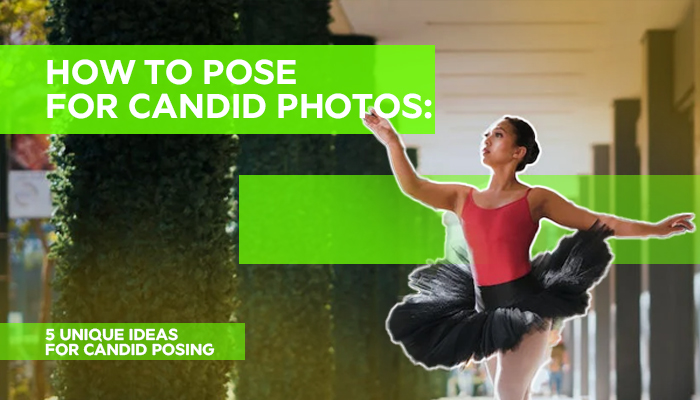A Complete Guide And Creative Photoshoot Ideas For Models
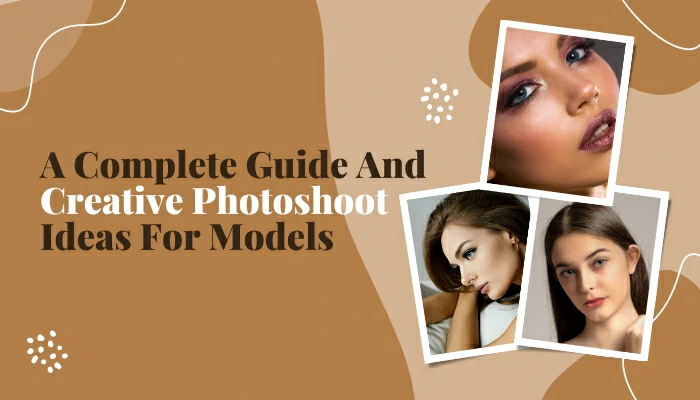
A well-executed model photoshoot plays a crucial role in attracting customers, boosting engagement, and ultimately increasing sales.
Professional photoshoots are essential for e-commerce success, particularly in the competitive fashion industry. Because here high-quality visuals significantly influence online shoppers to make a purchase.
Key elements for successful model photoshoots include clear concept development, thorough planning, technical proficiency, good rapport with models, and meticulous post-production editing.
Creative photoshoot ideas for models encompass various styles and settings, from lifestyle and vintage shoots indoors to outdoor themes like street style and action shots. Mastering posing techniques, incorporating movement, and using props are vital for models to convey emotions and enhance the impact of the photoshoot.
Table of Contents
The Importance of Model Photoshoots in Fashion
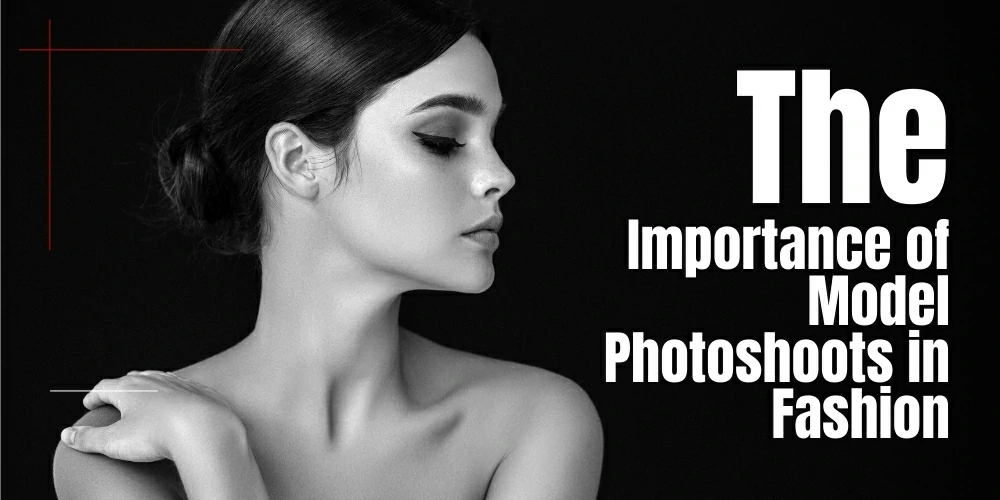
A study reveals that quality photos greatly influence purchases for 60% of online shoppers. So, In fashion aesthetics, high-quality professional photoshoots are essential.
A great photo shoot draws new customers, boosts engagement, and increases sales.
A well-executed photoshoot can transcend the boundaries of a mere product display. It becomes a captivating narrative that draws new customers, igniting their imagination and inspiring them to envision themselves wearing the featured garments.
Through the lens of a skilled photographer, the essence of a fashion brand is brought to life, creating an emotional connection that resonates with viewers.
Unveiling the World of Model Photoshoots

A model photoshoot is a meticulously planned photography session designed to showcase the beauty and versatility of clothing or the skills of a model. It involves careful attention to detail, from selecting the right location and wardrobe to choosing the most flattering poses and angles. The success of a photoshoot hinges on the photographer’s ability to capture the essence of the model and bring the client’s vision to life.
Key elements that contribute to a successful model photoshoot include:
- Concept and Vision: The photoshoot begins with developing a creative concept or theme that aligns with the client’s objectives. This could be anything from a high-fashion editorial spread to a commercial campaign or a personal portfolio. The photographer and the model work together to bring this vision to life through collaboration and expertise.
- Planning and Preparation: Thoroughly planning ensures a smooth and efficient photoshoot. This includes scouting for the best locations, selecting props and accessories, and coordinating the makeup, hair, and styling team. Proper preparation helps minimize surprises and ensures photographers have everything they need to capture the desired shots.
- Technical Proficiency: A successful model photoshoot requires technical proficiency from the photographer. They must deeply understand lighting, composition, and camera settings to create visually stunning images. The photographer’s ability to adapt to different environments and lighting conditions is essential to capturing the best possible shots, regardless of the circumstances.
- Rapport and Communication: Building a solid rapport with the model is vital for a successful photoshoot. The photographer must create a comfortable and supportive environment where the model feels at ease and confident. Clear communication between the photographer and the model is essential to ensure that both parties are on the same page and working towards the same goal.
- Post-Production and Editing: The photoshoot doesn’t end with the shutter’s click. Post-production and editing are crucial in enhancing the final images and achieving their full potential. The photographer uses editing software to adjust lighting, color, and composition and may also apply creative effects to achieve the desired look and feel.
Step-by-Step Guide to Planning a Model Photoshoot
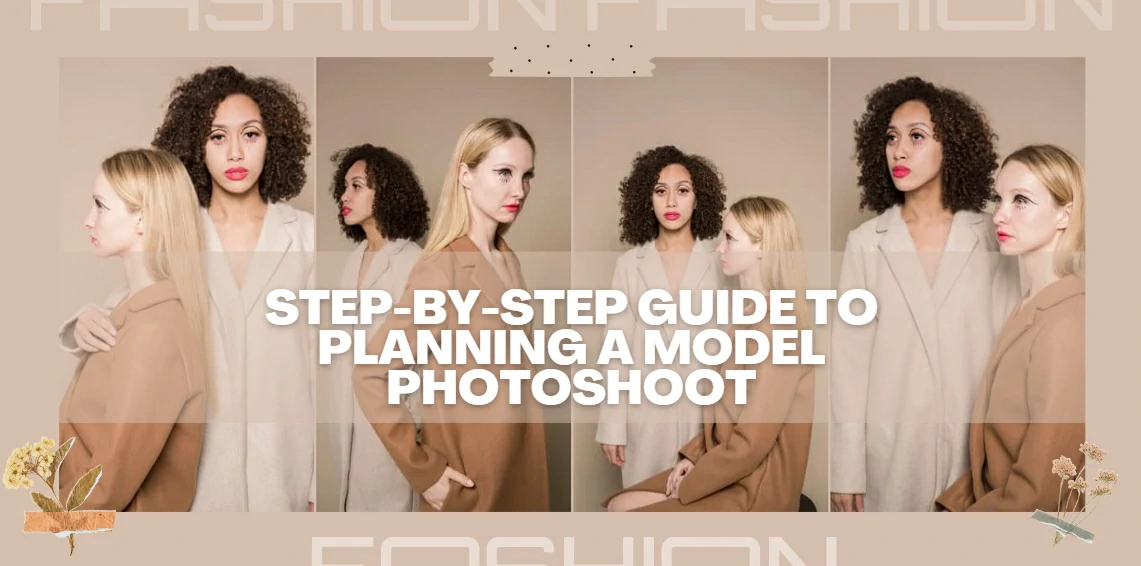
Before going into a model photoshoot, proper planning is essential. The man who is prepared has his battle half fought. Follow the below step-by-step guide to plan and do your model photoshoot properly.
Step 1: Define Your Concept
Define your concept, envisioning the final images. Consider the clothing, emotions, and themes to shape your location, lighting, and poses.
Step 2: Choose Your Location
When selecting a location for your photo shoot, several key factors come into play, all of which contribute to the overall success of your images. Here’s an expanded guide to help you make an informed decision:
-
Lighting:
- Consider the quality and direction of natural light. If shooting outdoors, plan your shoot for a golden hour (early morning or late afternoon) to capture that soft, flattering light. If shooting indoors, utilize large windows or artificial lighting to achieve the desired effect.
- Experiment with different lighting angles. Front lighting can create a flat, even look, while side lighting adds depth and dimension. Backlighting can create a dramatic, ethereal effect, but be careful not to overexpose your subject.
-
Backgrounds:
- Choose backgrounds that complement your subject and enhance the overall mood of your photos. Avoid distracting elements or backgrounds that compete with your subject for attention.
- Consider the texture, color, and pattern of your background. A simple, solid-colored backdrop can provide a clean, minimalist look, while a more textured or patterned background can add visual interest.
-
Environmental Elements:
-
- Please consider the surrounding environment and how it interacts with your subject. Incorporate natural elements such as trees, flowers, or water to add depth and context to your images.
- Consider the weather conditions. A clear, sunny day is ideal for most types of photography, but cloudy days can provide a softer, more diffused light. Rain or snow can create atmospheric and moody shots but be prepared to protect your equipment.
Step 3: Select Your Models
When selecting models for your photoshoot or creative project, it’s crucial to carefully consider their characteristics and how they align with your overall concept. Here are a few key factors to keep in mind:
Look:
- Physical Appearance: Consider whether the model’s physical features, such as hair color, eye color, skin tone, and body type, complement and enhance the visual aesthetic you’re aiming for.
- Style: Think about the model’s style and how it relates to the mood and theme of your project. Do their clothing choices and overall demeanor match the desired tone?
Age:
- Maturity: The model’s age can play a significant role in conveying a specific message or emotion. For example, a younger model might evoke a sense of innocence or freshness, while a more mature model could bring a sense of experience and wisdom.
Experience:
- Modeling Expertise: Assess the model’s experience level and comfort in front of the camera. An experienced model may be more adept at delivering the expressions and poses you’re looking for, while a less experienced model might bring a sense of naturalness and spontaneity.
Step 4: Hire Your Team
Assemble a professional team, including a makeup artist, hair stylist, wardrobe stylist, and assistant, for seamless execution.
Step 5: Prepare Your Equipment
Before the shoot starts, it is crucial to ensure that all equipment, ranging from cameras to props, is thoroughly prepared and tested. This meticulous step is essential to guarantee a smooth and successful filming process.
Check all cameras’ batteries, memory cards, lenses, and accessories. Test each camera for clear footage. Inspect props for damage. Repair or replace if needed to maintain quality.
Step 6: Execute the Photoshoot
Once you’ve found the perfect pose and lighting, it’s time to capture the best shots. Ensure your camera is set up correctly and you’re using the appropriate settings. Take your time and shoot multiple shots to ensure you get the perfect one. Remember to experiment with different angles and perspectives to add visual interest to your photos.
Step 7: Edit Your Images
You can’t use images directly from the camera. Post-process editors use Adobe Photoshop to edit efficiently and perfect images that you can use. Model photos are highly professional marketing visuals. They should go under only professional image editing process by expert editors. You can hire professional image editing service providers to get more benefits.
Creative Photoshoot Ideas for Models

Capturing masterpiece shots of models mostly depends on several things, such as lighting, locations, and many more. When you shoot indoors, the setup must be different from the outdoors. So, below, I have shared other creative photoshoot ideas for indoor and outdoor models.
Creative Indoor Photoshoot Ideas
- Lifestyle: Showcase models in natural settings like homes or coffee shops.
- Editorial: Craft high-fashion shoots reflecting the model’s unique style.
- Vintage: Capture timeless elegance with vintage-inspired shoots.
- Glamour: Highlight beauty in luxurious settings like hotels or red-carpet events.
- Boudoir: Create intimate portraits in a comfortable and trusting environment.
Outdoor Photoshoot Ideas
- Natural Settings: Showcase natural beauty in forests, beaches, or parks.
- Urban Settings: Create a gritty, edgy feel in urban environments like city streets or alleys.
- Travel: Capture models in exotic locations for a travel-themed shoot.
- Action Shots: Create dynamic images with models in action, jumping, running, or dancing.
- Street Style: Embrace street style with natural lighting and candid poses against unique backdrops.
Posing Tips for Model Photoshoots
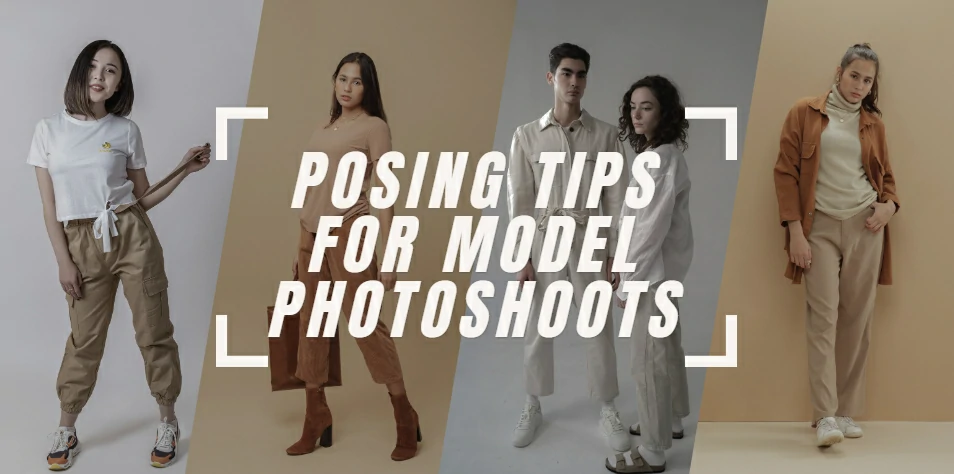
Mastering posing is crucial for models to convey emotions, flaunt features, and exhibit garment beauty. Whether a high-fashion editorial spread or a commercial campaign, the proper poses can elevate a photoshoot and bring the photographer’s vision to life.
- Use Natural Poses: Avoid stiffness; opt for natural poses that showcase beauty and style.
- Create Movement: Add dynamism to poses for engaging images.
- Use Props: Integrate props fitting the theme and style.
- Consider Angles and Perspective: Experiment with angles for depth and interest.
- Facial Expressions: Encourage varied expressions to convey different moods.
Best Model Poses
- Classic Headshot: Focus on the model’s face, looking straight or slightly to the side.
- The S-curve: Form an S-shape with one shoulder higher, a classic for Fashion Photography.
- Leaning Pose: Create movement as the model leans against a wall or tree.
- Sitting Pose: Showcase elegance and poise with the model seated.
- Action Pose: Capture dynamic images with jumping, running, or dancing.
Bonus Tips for Models During Photoshoots
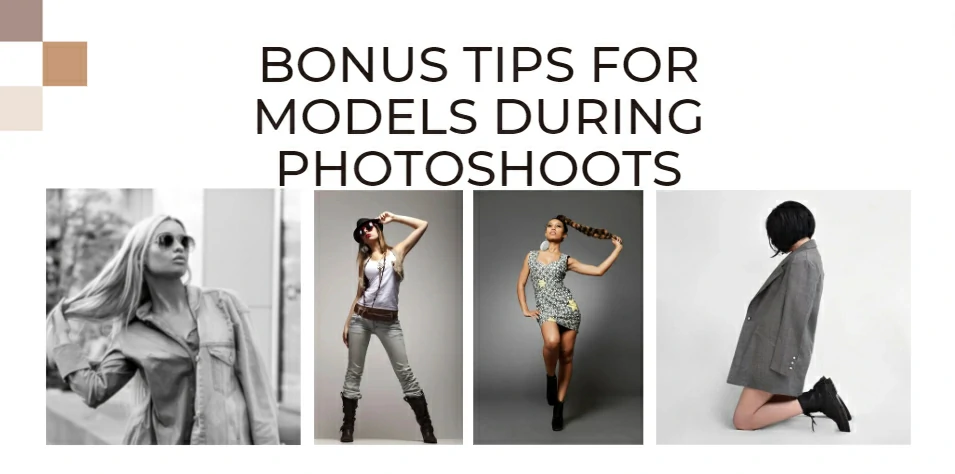
No matter how well you plan, there might be some inconveniences during the photoshoot. To avoid those, here are some bonus tips that you can consider.
- Communicate Clearly: Follow instructions on poses and expressions.
- Be Patient: Allow beginner models time to get comfortable in front of the camera.
- Provide Direction: Guide models on poses, looks, and prop usage.
- Give Feedback: Offer constructive feedback to help models improve.
- Be Supportive: Encourage and provide positive feedback for confidence.
Conclusion
In conclusion, mastering model photoshoots is an art that can elevate your brand and captivate your audience. With meticulous planning, creative execution, and innovative tools like Clipping Path Graphics, you can create stunning visuals that set your brand apart in the competitive fashion market.
Don’t wait;
Sign up for Clipping Path Graphics today and unleash the power of captivating imagery to drive sales and brand success.



